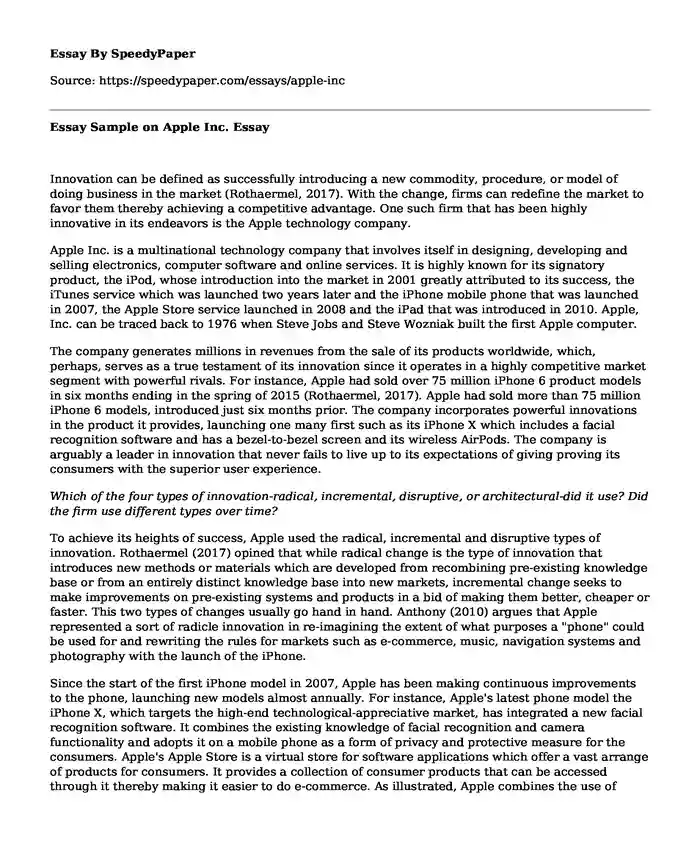
| Type of paper: | Critical thinking |
| Categories: | Company Information technologies Leadership style |
| Pages: | 3 |
| Wordcount: | 688 words |
Innovation can be defined as successfully introducing a new commodity, procedure, or model of doing business in the market (Rothaermel, 2017). With the change, firms can redefine the market to favor them thereby achieving a competitive advantage. One such firm that has been highly innovative in its endeavors is the Apple technology company.
Apple Inc. is a multinational technology company that involves itself in designing, developing and selling electronics, computer software and online services. It is highly known for its signatory product, the iPod, whose introduction into the market in 2001 greatly attributed to its success, the iTunes service which was launched two years later and the iPhone mobile phone that was launched in 2007, the Apple Store service launched in 2008 and the iPad that was introduced in 2010. Apple, Inc. can be traced back to 1976 when Steve Jobs and Steve Wozniak built the first Apple computer.
The company generates millions in revenues from the sale of its products worldwide, which, perhaps, serves as a true testament of its innovation since it operates in a highly competitive market segment with powerful rivals. For instance, Apple had sold over 75 million iPhone 6 product models in six months ending in the spring of 2015 (Rothaermel, 2017). Apple had sold more than 75 million iPhone 6 models, introduced just six months prior. The company incorporates powerful innovations in the product it provides, launching one many first such as its iPhone X which includes a facial recognition software and has a bezel-to-bezel screen and its wireless AirPods. The company is arguably a leader in innovation that never fails to live up to its expectations of giving proving its consumers with the superior user experience.
Which of the four types of innovation-radical, incremental, disruptive, or architectural-did it use? Did the firm use different types over time?
To achieve its heights of success, Apple used the radical, incremental and disruptive types of innovation. Rothaermel (2017) opined that while radical change is the type of innovation that introduces new methods or materials which are developed from recombining pre-existing knowledge base or from an entirely distinct knowledge base into new markets, incremental change seeks to make improvements on pre-existing systems and products in a bid of making them better, cheaper or faster. This two types of changes usually go hand in hand. Anthony (2010) argues that Apple represented a sort of radicle innovation in re-imagining the extent of what purposes a "phone" could be used for and rewriting the rules for markets such as e-commerce, music, navigation systems and photography with the launch of the iPhone.
Since the start of the first iPhone model in 2007, Apple has been making continuous improvements to the phone, launching new models almost annually. For instance, Apple's latest phone model the iPhone X, which targets the high-end technological-appreciative market, has integrated a new facial recognition software. It combines the existing knowledge of facial recognition and camera functionality and adopts it on a mobile phone as a form of privacy and protective measure for the consumers. Apple's Apple Store is a virtual store for software applications which offer a vast arrange of products for consumers. It provides a collection of consumer products that can be accessed through it thereby making it easier to do e-commerce. As illustrated, Apple combines the use of these two innovations in different periods
Disruptive innovation is a type of change that uses new technologies to lure an existing market to buy the products being offered. Apple used disruptive innovation in the launch of the iPod. It was a simple, smaller and more elegant mp3 system that could store larger quantities of music in a much smaller hardware component. The launch of iTunes in 2003 also disrupted the music industry by providing a platform where music could be accessed at much lower costs. The AirPod, which was launched in 2018 might also be another innovative product which makes it more efficient to use earplugs by getting rid of hardwire connections between the phone and the earplugs.
References
Anthony, S. D. (2017). "Three critical, innovative lessons from Apple." Havard Business Review.
Harvard Business Publishing.[online]. Retrieved from: https://hbr.org/2010/05/three-critical-innovation-lessRothaermel, F. T. (2017). Strategic management concepts (Custom 3rd ed.) New York, NY: McGraw-Hill.
Cite this page
Essay Sample on Apple Inc.. (2022, Dec 16). Retrieved from https://speedypaper.net/essays/apple-inc
Request Removal
If you are the original author of this essay and no longer wish to have it published on the SpeedyPaper website, please click below to request its removal:
- Samsung Conglomerate Essay Sample
- Media Essay Sample: The Impact of Twitter on Agenda Sitting in Newsroom - Dubai News Center
- Free Essay Example: Psychological Theory and Practice
- Business Essay Example: Pfizer's Hostile Warner-Lambert Takeover
- Islamophobia in My Name Is Khan, Free Essay Sample
- Module 11 - Islam and the Quran
- Free Essay Sample: Genetic Knowledge
Popular categories




